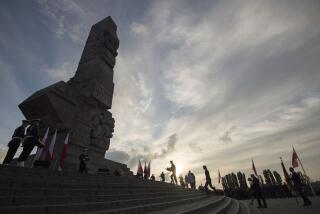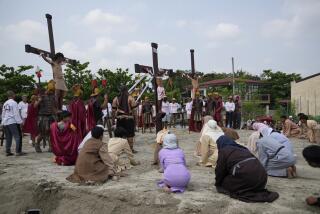Grisly Find Forces Japan to Face Past
- Share via
TOKYO — Tucked behind railroad tracks in an industrial corner of Tokyo’s gray sprawl, a huge stone Buddha stands guard over a quiet, lonely graveyard.
The Buddha has stood for centuries, but it is on few maps and no sightseeing tours. It is known as the “beheading Buddha,” and it marks the site of an execution ground where as many as 200,000 people were killed and buried in centuries past.
Workers digging at a construction site recently unearthed more than 100 skulls--and generated a good deal of interest in this long-forgotten dark spot in the history of Tokyo.
The discovery was widely covered by the Japanese media and was followed by a formal archeological excavation.
“It’s amazing how it has aroused people’s awareness,” said Ryosho Mizuno, priest of the nearby Enmeiji Temple. “Some people are even coming in groups to see.”
All told, 105 skulls were dug up. Many bore the telltale marks of the samurai swords.
The site was one of two main locations in the capital used for executions during Japan’s feudal period. It was a killing ground for about 220 years until it was closed about a century ago.
Historians say as many as 200,000 people were beheaded by samurai sword; their heads were buried in a shallow mound without cremation. Their bodies apparently were buried elsewhere, because only skulls have been found at the site.
Today, the beheading ground is virtually unmarked.
Enmeiji--the “Temple of Prolonging Life”--and another Buddhist temple manage graveyards in the area. Small memorials to the dead are displayed on their grounds.
“There is a deep-rooted notion that the dark side of history should be erased as quickly as possible,” said Hideaki Iyoku, curator of the Criminal Museum of Tokyo’s Meiji University. “But if we turn away from the negative side of the past, we won’t be able to grasp history well.”
The execution site was brought back into the public eye by a construction worker digging a trench to lay cable for a railway project. At just over three feet below the surface, he found human skulls atop a wooden chest.
Police and district education board officials were called in, and they eventually dug up the 105 skulls.
“Deeper down, there could be more skulls,” said Akiko Yano, a researcher present at the dig.
She said the search was halted because of the watery condition of the ground. By law, the owner of the land or the construction company must pay for such excavations, and officials determined they had done enough.
Still, researchers said the find was significant.
“It’s rare for such a large number of human skulls to be discovered at once,” said Kiyohiko Sakurai, professor of archeology at Showa Women’s University. “This provides us with more material for studies.”
Sakurai said DNA will be taken for genetic tests and the skulls will be studied for clues to diet and nutrition of the time. The skulls are now at the National Science Museum.
Little is known of the execution ground’s history.
The 330-year-old Ekoin Temple, the other temple there, possesses one of the few remaining artifacts--a sword believed to have been used in the executions, priest Keisho Mizuno said.
“Nothing else has been left with us,” he said.
The beheading Buddha at the Enmeiji Temple is another remnant. The 12-foot-tall statue is in the image of Jizo, a Buddha believed to look after the souls of the dead. It was built in 1741.
“The statue is the sole reminder of the execution site,” said the Enmeiji priest, Mizuno. “There is nothing else.”
He said he is trying to keep the memory of the site alive and plans to resume a monthly rite centered on the statue. The rite hasn’t been held for 50 years.
But he said it may take time before people are willing to face the area’s past.
“Maybe the next generation will be more concerned with history,” he said.
More to Read
Sign up for Essential California
The most important California stories and recommendations in your inbox every morning.
You may occasionally receive promotional content from the Los Angeles Times.













